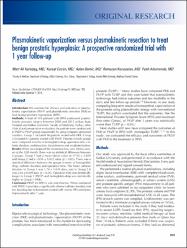| dc.contributor.author | Karadağ, Mert Ali | |
| dc.contributor.author | Çeçen, Kürşat | |
| dc.contributor.author | Demir, Aslan | |
| dc.contributor.author | Kocaaslan, Ramazan | |
| dc.contributor.author | Altunrende, Fatih | |
| dc.date.accessioned | 2014-11-28T09:19:15Z | |
| dc.date.available | 2014-11-28T09:19:15Z | |
| dc.date.issued | 2014 | |
| dc.identifier.citation | Karadag MA, Cecen K, Demir A, Kocaaslan R, Altunrende F. Plasmakinetic vaporization versus plasmakinetic resection to treat benign prostatic hyperplasia: A prospective randomized trial with 1 year follow-up. Canadian Urological Association Journal. 2014; 8(9-10): E595-599. doi: 10.5489/cuaj.1902. | en_US |
| dc.identifier.issn | 1911-6470 | |
| dc.identifier.uri | http://www.ncbi.nlm.nih.gov/pmc/articles/PMC4164545/ | en_US |
| dc.identifier.uri | https://hdl.handle.net/11446/578 | en_US |
| dc.description | İstanbul Bilim Üniversitesi, Tıp Fakültesi. | en_US |
| dc.description.abstract | Introduction: We evaluate the efficacy and outcomes of plasma-kinetic vaporization (PKVP) and plasmakinetic resection (PKR) to treat benign prostatic hyperplasia (BPH).
Methods: A total of 183 patients with BPH underwent plasmakinetic prostatic surgery between 2008 and 2012 at Kars State Hospital and Kafkas University Faculty of Medicine, Turkey. After clinical and preoperative evaluation, the patients were randomized to PKRP or PKVP groups sequentially by using computer-generated numbers. Group 1 included 96 patients treated with PKR. Group 2 included 87 patients treated with PKVP. Patients in both groups were compared in terms of hemoglobin drop, operation time, catheter duration, reobstruction, incontinence and recatheterization.
Results: When we compared the maximum flow rates (Qmax values) at the 12th month, there was no statistical difference between 2 groups. Group 1 had a mean Qmax value of 17.92 +/- 3.819 and Group 2 had a 18.15 +/- 3.832 value (p > 0.05). There was a statistical difference between the groups in terms of hemoglobin drop, catheter duration and operation time. The mean catheter duration in Group 1 was 3.74 +/- 1.049 days, and in Group 2 it was 2.64 +/- 0.849 days (p < 0.05). Operation time was statistically longer in Group 2 (PKVP) and hemoglobin drop was statistically higher in Group 1 (PKR).
Conclusion: PKVP for BPH is safe and effective. When compared with PKRP, it provides a significantly shorter catheter duration and less bleeding due to hemostasis control with similar IPSS and Qmax improvements after 1 year. | en_US |
| dc.language.iso | eng | en_US |
| dc.publisher | Canadian Urological Association | en_US |
| dc.rights | info:eu-repo/semantics/openAccess | en_US |
| dc.title | Plasmakinetic vaporization versus plasmakinetic resection to treat benign prostatic hyperplasia: A prospective randomized trial with 1 year follow-up | en_US |
| dc.type | article | en_US |
| dc.relation.journal | Canadian Urological Association Journal | en_US |
| dc.department | DBÜ, Tıp Fakültesi | en_US |
| dc.identifier.issue | 9-10 | |
| dc.identifier.volume | 8 | en_US |
| dc.identifier.startpage | E595 | |
| dc.identifier.endpage | E599 | |
| dc.contributor.authorID | TR48928 | en_US |
| dc.contributor.authorID | TR58583 | en_US |
| dc.contributor.authorID | TR201992 | en_US |
| dc.contributor.authorID | TR177373 | en_US |
| dc.contributor.authorID | TR105959 | en_US |
| dc.relation.publicationcategory | Belirsiz | en_US |


















